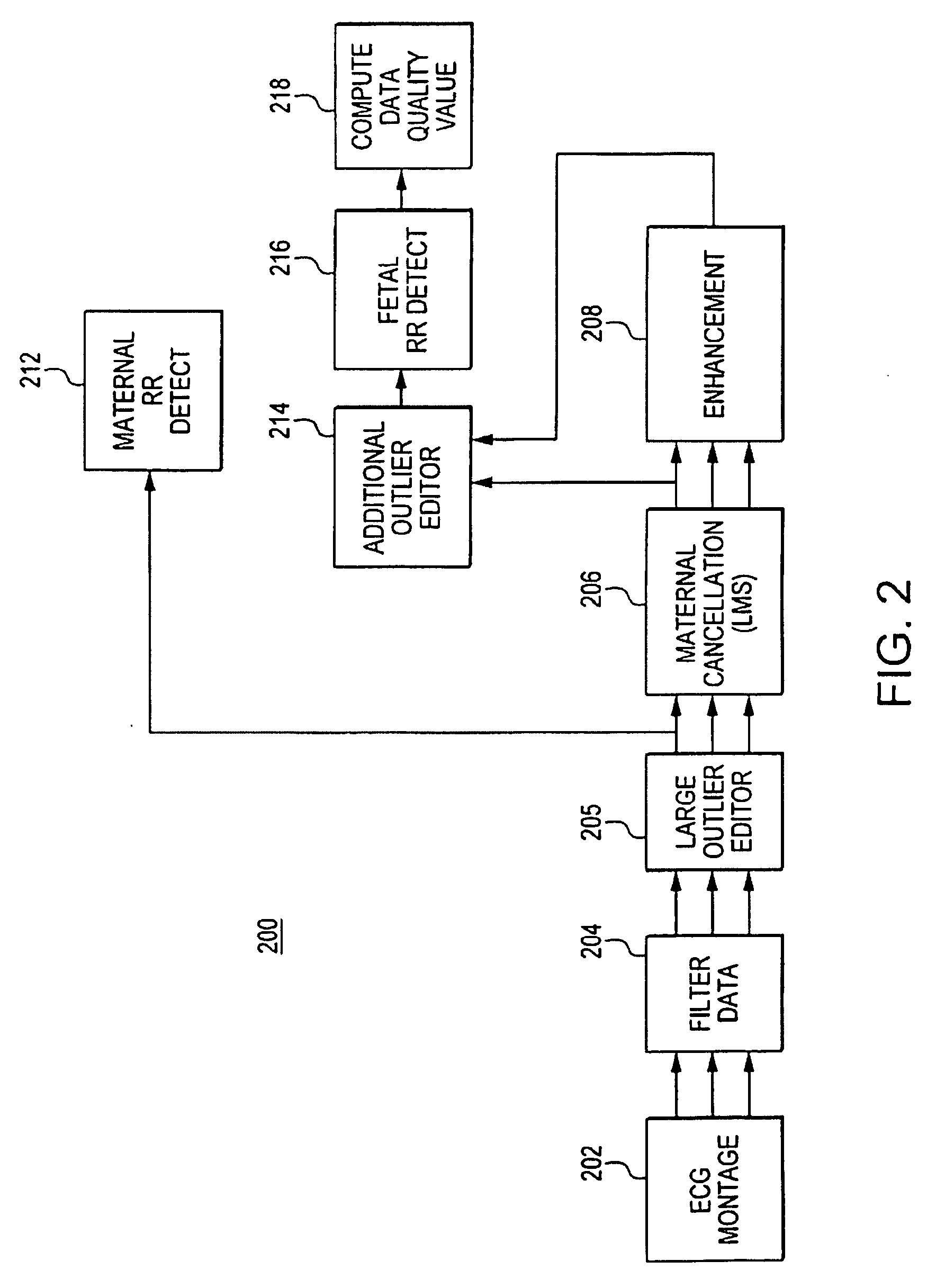Apparatus and Method for Non-Invasive, Passive Fetal Heart Monitoring
a passive, fetal heart rate technology, applied in the field of biomedical devices, can solve the problems of limiting the number of input channels that can be collected, ambiguous estimation, and unsatisfactory methods, and achieves the effects of preserving the signal to noise, maximizing the health and well-being of the mother, and facilitating the use of the devi
- Summary
- Abstract
- Description
- Claims
- Application Information
AI Technical Summary
Benefits of technology
Problems solved by technology
Method used
Image
Examples
first embodiment
[0038]With reference now to FIG. 2, there is shown and described a block diagram of a system data flow 200, according to an embodiment of the invention.
[0039]System data flow 200 represents an advance over the system data flow 100 of FIG. 1 in that it incorporates quantitative metrics to monitor the quality of the fetal ECG data at the various processing stages. The metrics are derived from measurements of the fetal ECG (e.g., variation of timing in the R-wave peaks), described further below.
[0040]Some elements of the system data flow 200 are similar to respective elements of the system data flow 100 illustrated in FIG. 1. That is, the data flow 200 includes an ECC montage 102, a data filter 104, a maternal cancellation stage 106, and an enhancement stage 108.
[0041]In addition to these known elements from the system data flow 100 of FIG. 1, to facilitate the incorporation of quantitative metrics to monitor the quality of the fetal ECG data, additional processing stages are incorpora...
second embodiment
[0042]With reference now to FIG. 3, there is shown and described a block diagram of a system 300, according to another embodiment of the invention. The system 300 is distinguishable from the previously described embodiment in that the presently described system 300 in addition to incorporating quantitative metrics to monitor the quality of the fetal ECG data, the present embodiment further includes a control feedback layer which serves to monitor the processing results at defined time intervals. The present embodiment further provides capabilities for dynamically forming signal vectors (i.e., input channels) by means of unipolar data acquisition to maximize the number of high quality input channels with a minimum of hardware.
[0043]In the present embodiment, processing results are autonomously monitored on both a short time-scale 250, on the order of 10 to 30 seconds and a long time-scale 240, on the order of 1 to 2 minutes. The short time-scale monitors one channel of the fetal ECG ...
example 1
[0090]FIG. 8 is a first example that illustrates samples of FHM measurements; the related metric values that were computed for this sample as included as Table I, below. It is noted that FIG. 8 shows only a few seconds of waveform, while the metrics were computed from a longer segment of data—typically 30 seconds.
[0091]FIG. 8 is taken from a sample with well developed, regular R-wave peaks and illustrates typical metric values for a good data sample. For this measurement, SNR exceeds 12 (the largest values we have observed on any measurement are about 15).
[0092]Referring to Table I. below, depending on whether the mean (‘foutl_mn’) or the median (‘foutl_med’) measure is used, 18 to 25 percent of peak-to-peak intervals are tagged as outliers. (The best cases observed give around 10%; the worst 65%.) We find that the median measure of peak-to-peak variability (‘fdT_med’) is a somewhat better measure of peak-to-peak variability than the standard deviation (‘fdT_var’). For this example ...
PUM
 Login to View More
Login to View More Abstract
Description
Claims
Application Information
 Login to View More
Login to View More - R&D
- Intellectual Property
- Life Sciences
- Materials
- Tech Scout
- Unparalleled Data Quality
- Higher Quality Content
- 60% Fewer Hallucinations
Browse by: Latest US Patents, China's latest patents, Technical Efficacy Thesaurus, Application Domain, Technology Topic, Popular Technical Reports.
© 2025 PatSnap. All rights reserved.Legal|Privacy policy|Modern Slavery Act Transparency Statement|Sitemap|About US| Contact US: help@patsnap.com



